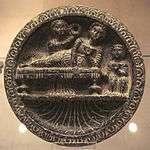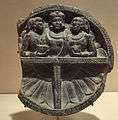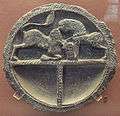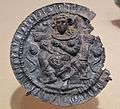Stone palette
Stone palettes, also called toilet trays, are round trays commonly found in the areas of Bactria and Gandhara, which usually represent Greek mythological scenes. Some of them are attributed to the Indo-Greek period in the 2nd and 1st century BCE (a few were retrieved from the Indo-Greek stratum No.5 at Sirkap.) Many are considered to be of later production, around the 1st century CE during the time of the Indo-Parthians. They practically disappeared after the 1st century. Many have been found at the archaeological site of Sirkap, in today's Pakistan.
Function
Scholars have suggested that these trays were used to mix cosmetic products (cf. ancient Egyptian cosmetic palettes). The Ancient Orient Museum was able to analyse the remains of substances adhering to a number of stone palettes, which turned out to be colored cosmetic powders akin to blush. A frieze discovered in Butkara shows a woman using a mirror as she puts her fingers into one of these stone palettes.[1]
These stone palettes provide an interesting instance of Hellenistic art in the northwestern Indian subcontinent. They are disconnected from the Buddhist narrative to which works are usually associated in the Greco-Buddhist art of Gandhara.
Few of the palettes contain representations of the Buddha.
Crescent-shaped divided bowl
 Apollo and Daphne.
Apollo and Daphne. Couple with sea serpent.
Couple with sea serpent.
- Poseidon with attendants. Ancient Orient Museum.
- Aphrodite at her bath.
- Man with cup in hand, riding a Ketos sea-monster.
- Banquet or funerary scene.
 Banquet or funerary scene.
Banquet or funerary scene. Female triton, Tokyo National Museum
Female triton, Tokyo National Museum- Stone palette and other artifacts found in the Indo-Greek level at Sirkap (Stratum 5)
 Friendly animals.
Friendly animals. Equestrian stone palette, Gandhara.
Equestrian stone palette, Gandhara.
T-shape dividers
- Indo-Parthian king and attendants.
 Indian nobleman with female attendants.
Indian nobleman with female attendants.- Possible fire worship with altar.
- Indo-Greek drinking party.
- Indo-Parthian revelers.
- Indo-Parthian couple.
 Fighting animals.
Fighting animals. Reveling couple.
Reveling couple.
Other shapes
 Drunk Herakles.
Drunk Herakles.- Indo-Greek festivities.
- Indo-Parthian man hunting.
- Man riding a Ketos sea-monster.
- Man with cup, riding a Ketos sea-monster.
- Woman in Greek clothing, riding a Ketos sea-monster.
 Palette with the Goddess Hariti.
Palette with the Goddess Hariti.
See also
Notes
- ↑ Report of the Italian mission to Butkara.
References
- Francfort, Henri-Paul "Les Palettes du Gandhara" 1979 (in French). Paris: Diffusion de Brocard.